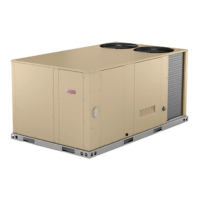Page 15
B-Refrigerant Charge and Check
WARNING-Do not exceed nameplate charge under any condition.
This unit is factory charged and should require no further
adjustment. If the system requires additional refrigerant,
reclaim the charge, evacuate the system, and add
required nameplate charge.
NOTE - System charging is not recommended below
60F (15C). In temperatures below 60F (15C) , the
charge must be weighed into the system.
If weighing facilities are not available, or to check the
charge, use the following procedure:
1- Attach gauge manifolds and operate unit in cooling
mode with economizer disabled until system
stabilizes (approximately five minutes).
2- Check each system separately with all stages
operating.
3- Use a thermometer to accurately measure the
outdoor ambient temperature.
4- Apply the outdoor temperature to tables 6 through 8
to determine normal operating pressures.
Pressures
are listed for sea level applications at 80°F dry bulb
and 67°F wet bulb return air.
5- Compare the normal operating pressures to the
pressures obtained from the gauges. Minor
variations in these pressures may be expected due to
differences in installations. Significant differences
could mean that the system is not properly charged
or that a problem exists with some component in the
system. Correct any system problems before
proceeding.
TABLE 6
KHC092S NORMAL OPERATING PRESSURES
Outdoor
Coil
Entering
Air Temp
CIRCUIT 1 CIRCUIT 2
Dis
charge
+
10 psig
Suction
+
5 psig
Dis
charge
+
10 psig
Suction
+
5 psig
65°F 256 132 265 137
75°F 293 133 304 138
85°F 334 135 351 140
95°F 380 137 401 142
105°F 432 140 456 144
115°F 491 143 519 147
TABLE 7
KHC102S NORMAL OPERATING PRESSURES
Outdoor
Coil
Entering
Air Temp
CIRCUIT 1 CIRCUIT 2
Dis
charge
+
10 psig
Suction
+
5 psig
Dis
charge
+
10 psig
Suction
+
5 psig
65°F 255 128 250 139
75°F 295 128 291 141
85°F 334 129 329 143
95°F 376 131 375 145
105°F 426 133 425 147
115°F 478 136 479 150
TABLE 8
KHC150S NORMAL OPERATING PRESSURES
Outdoor
Coil
Entering
Air Temp
CIRCUIT 1 CIRCUIT 2
Dis
charge
+
10 psig
Suction
+
5 psig
Dis
charge
+
10 psig
Suction
+
5 psig
65°F 250 127 267 128
75°F 286 128 306 129
85°F 326 128 348 131
95°F 368 129 395 133
105°F 415 131 445 136
115°F 469 133 502 141
6- If discharge pressure is high, remove refrigerant from
the system. If discharge pressure is low, add
refrigerant to the system.
Add or remove charge in increments.
Allow the system to stabilize each time
refrigerant is added or removed.
7- Use the following approach method along with the
normal operating pressures to confirm readings.
C-Charge Verification - Approach Method - AHRI Testing
1- Using the same thermometer, compare liquid
temperature to outdoor ambient temperature.
Approach Temperature = Liquid temperature (at
condenser outlet) minus ambient temperature.
2- Approach temperature should match values in table
9. An approach temperature greater than value
shown indicates an undercharge. An approach
temperature less than value shown indicates an
overcharge.
3- The approach method is not valid for grossly over or
undercharged systems. Use tables 6 through 8 as a
guide for typical operating pressures.
TABLE 9
APPROACH TEMPERATURE
Unit
Liquid Temp. Minus Ambient Temp.
1st Stage 2nd Stage
092S 5°F + 1 (2.8°C + 0.5) 4°F + 1 (2.2°C + 0.5)
102S 5°F + 1 (2.8°C + 0.5) 5°F + 1 (2.8°C + 0.5)
120S 4°F + 1 (2.2°C + 0.5) 7°F + 1 (3.9°C + 0.5)

